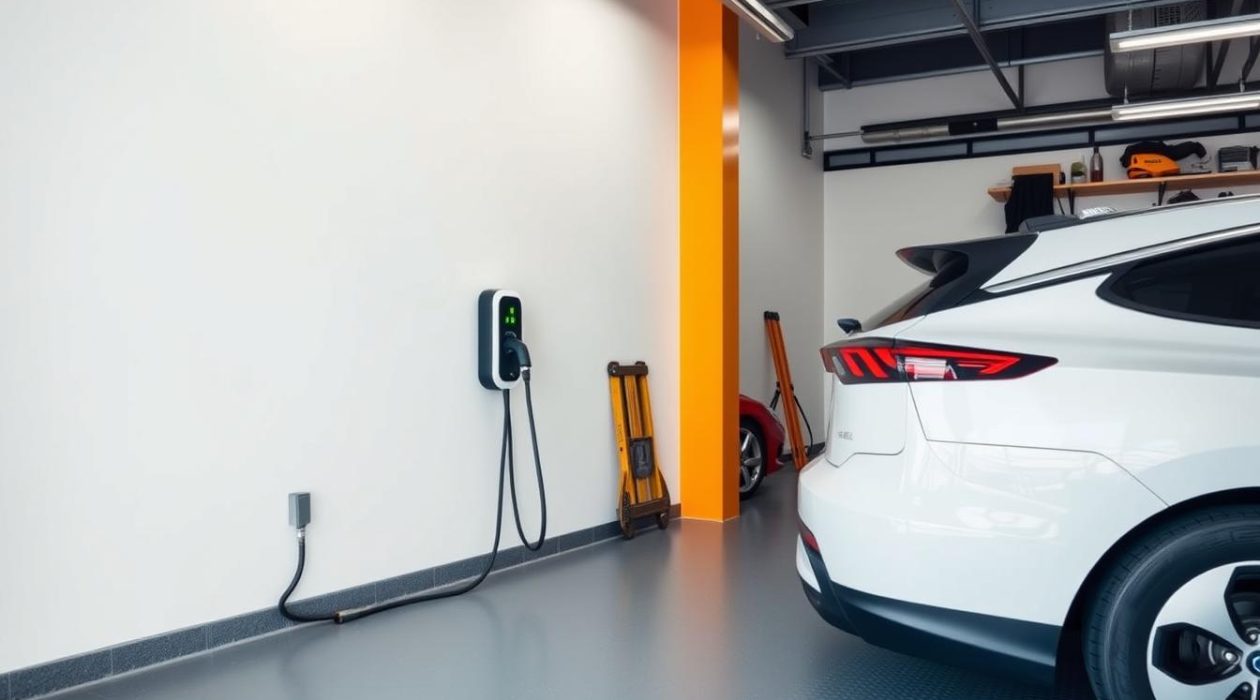As the world moves towards electric vehicles, setting up an EV charging station at home is smart. It saves money and time. The US Department of Energy says EV charging at home is a great option. With the right tools and setup, charging your car at home is easy.
If you own an EV or are thinking about getting one, knowing how to set up a charging station is key. This article will guide you through EV charging basics, choosing the right equipment, and ensuring safety. We’ll cover everything you need to know.
Key Takeaways
- Installing an EV charging station at home can save you money and time on EV charging.
- Understanding the basics of EV charging is essential for a successful installation.
- Choosing the right equipment for your electric vehicle is crucial for efficient EV charging.
- Ensuring safety is a top priority when installing an EV charging station at home.
- A properly installed EV charging station can increase your home’s value and make it more attractive to potential buyers who own an electric vehicle.
- EV charging at home can be a convenient and cost-effective way to charge your electric vehicle.
Understanding Home EV Charging Basics
Electric vehicles are getting more popular, so it’s key to know about home EV charging. You need to think about your car’s power requirements, the installation process, and charging safety. The US Department of Energy has info on EV chargers like Level 1, Level 2, and DC Fast Charging.
Choosing a charger for your home depends on your car’s power requirements and what you prefer. Level 1 uses a standard 120-volt outlet, while Level 2 needs a 240-volt outlet. DC Fast Charging is mostly for commercial use.
Different Types of EV Chargers
- Level 1: Uses a standard 120-volt outlet
- Level 2: Requires a 240-volt outlet
- DC Fast Charging: Typically used for commercial purposes
Knowing how to install a charger is important. You should hire a licensed electrician and check if your home’s electrical system can handle it. Also, make sure to follow charging safety steps, like using a charger with safety features and charging correctly.
Assessing Your Home’s Electrical System
Before you install an EV charging station, check your home’s electrical system. It must handle the power requirements of the charger. You might need an electrical upgrade to support it. The National Electric Code says a detailed check is key to meet the demand.
A licensed electrician can assess your system and suggest upgrades. This could mean a new main panel, wiring, or a dedicated circuit for the charger. This ensures your EV charges safely and reliably.
- Current electrical panel capacity
- Available power supply
- Condition and age of existing wiring
By looking at these, you can see if your system can handle the power requirements of your EV charger. If not, you might need an electrical upgrade for safe and efficient charging.
Cost Considerations for EV Charging Installation
Installing an EV charging station comes with several costs to consider. The installation process can be simple or complex, affecting the price. You might also need an electrical upgrade to support the station, which adds to the cost.
The price of the charging station itself can be between $300 and $1,000. This depends on its type and features. Labor costs for installation can range from $400 to $1,500, based on the job’s complexity. Upgrades to your electrical panel can also increase the cost.
But, there are tax incentives available to help with the costs. It’s important to look into these before starting the installation. Here’s a table showing some estimated costs for EV charging installation:
| Component | Estimated Cost |
|---|---|
| Charging Station | $300 – $1,000 |
| Installation Labor | $400 – $1,500 |
| Utility Upgrades | $500 – $2,000 |
Knowing these costs helps you plan better for your EV charging station. This way, you can have a smooth and efficient installation process for your new charging station, which might need an electrical upgrade.
Required Permits and Regulations
When you install an EV charging station, following local and national rules is key. You need the right permits and make sure it’s safe. Code compliance is vital to avoid safety risks and make charging safe.
To keep things safe, you must know the rules in your area. This means following the National Electric Code and local building codes. Here are important rules to keep in mind:
- Get the needed permits before you start
- Make sure the installation is safe
- Follow the National Electric Code and local building codes
By sticking to these rules and ensuring code compliance, you’ll have a safe and efficient EV charging experience. Always put charging safety first when setting up an EV charging station.
Choosing the Right EV Charging Equipment
When you own an electric vehicle, picking the right charger is key. The US Department of Energy says the right charger makes charging safe and efficient. Think about your power needs and how they affect your charging station choice.
There are many chargers to choose from. Here are a few:
- Level 1 charging, which uses a standard 120-volt outlet
- Level 2 charging, which requires a 240-volt outlet and can charge your vehicle more quickly
- DC Fast Charging, which can charge your vehicle to 80% in under 30 minutes
Also, consider smart charging features. These let you watch and control your charging. Features like remote monitoring, scheduling, and tracking energy use are useful. The right charger ensures safe and efficient charging, meeting your power needs and enhancing your electric vehicle experience.
| Charging Equipment | Power Requirements | Charging Time |
|---|---|---|
| Level 1 | 120-volt outlet | 12-24 hours |
| Level 2 | 240-volt outlet | 4-8 hours |
| DC Fast Charging | 480-volt outlet | 30 minutes |
Professional Installation Process and Timeline
Installing an EV charging station needs a licensed electrician for safety and compliance. The National Electric Code says this is the best way to avoid risks. The electrical upgrade needed can change based on the charger type and project complexity.
The installation process can take a few hours to several days. It’s important to plan and schedule the installation to avoid daily routine disruptions. Here are the main steps in the installation process:
- Checking your home’s electrical system to see if an electrical upgrade is needed
- Getting the necessary permits and approvals
- Putting in the EV charging station and linking it to your electrical system
- Testing the charging station to make sure it’s safe and working right
By choosing a licensed electrician and following the installation process, you get a safe and efficient electrical upgrade. This makes charging your electric vehicle easy and reliable. You’ll also feel confident knowing the installation was done right.
Safety Features and Best Practices for EV Charging
Electric vehicle (EV) charging safety is a big deal. It’s all about charging safety and code compliance to avoid accidents. The National Electric Code says following safety rules is key to meet local and national standards.
Understanding EV charging safety is crucial. This includes:
- Circuit protection to stop overloads and short circuits
- Emergency shut-off systems for quick hazard response
- Maintenance tips to keep charging equipment working well
By sticking to these guidelines and code compliance rules, EV owners can charge safely and efficiently. Regular checks and maintenance can spot problems early. This keeps charging safety high and makes the equipment last longer.
Also, keeping up with EV charging tech and safety is smart. It helps owners make better choices for their charging setup. By focusing on charging safety and code compliance, EV owners can charge without worry. They also help make transportation safer and greener.
| Safety Feature | Description |
|---|---|
| Circuit Protection | Prevents overloads and short circuits |
| Emergency Shut-off | Quickly responds to potential hazards |
| Maintenance Guidelines | Ensures charging equipment is in good working condition |
Maximizing Your Home EV Charging Experience
To get the most out of your electric vehicle and charging station, it’s key to know your power needs and charging habits. The US Department of Energy says optimizing your charging can cut costs and lessen environmental harm. By looking at your car’s battery size and daily driving, you can make a charging plan that fits you.
Some ways to make the most of your home EV charging include:
- Installing a smart charging system that can adjust your charging schedule based on your energy use and the time of day
- Using a charging station with a high power output to cut down charging time
- Practicing energy-saving habits, like turning off lights and appliances when not in use, to lower your energy use
By being thoughtful and informed about your home EV charging, you can have a convenient, affordable, and green driving experience. As you keep using your electric vehicle and charging station, watch your energy use and tweak your charging plan as needed. This ensures you’re getting the best from your investment.
By following these tips and keeping up with electric vehicle tech, you can enhance your home EV charging experience. Enjoy a smooth, efficient, and eco-friendly drive.
| Charging Station Type | Power Output | Charging Time |
|---|---|---|
| Level 1 | 120V | 12-24 hours |
| Level 2 | 240V | 4-8 hours |
| DC Fast Charging | 480V | 30 minutes-1 hour |
Conclusion: Powering Your Electric Future at Home
As electric vehicles (EVs) become more popular, getting an EV charging station at home is a smart move. Learning about home EV charging and checking your home’s electrical system is key. This way, you can charge your car easily and efficiently.
Home EV charging offers many perks. It lets you fill up your car right at home, saving you money and reducing pollution. Plus, with tax breaks and rebates, getting a home charging station can be a smart financial choice.
Starting your electric journey? Make sure to focus on safety and follow the best practices. Use the right circuit protection, have an emergency shut-off, and keep your system in good shape. With careful planning, you’ll be ready to power your electric future from home.


